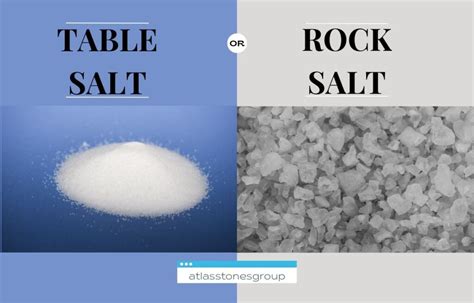Salt, an essential mineral for human health, plays a crucial role in regulating bodily functions and maintaining electrolyte balance. While there are various types of salt available, two common varieties stand out: rock salt and table salt. This article delves into the differences between these two salt types, examining their origins, composition, health implications, and culinary uses.

Origins and Composition
Rock Salt
Rock salt, also known as halite, is a naturally occurring mineral formed from crystallized seawater that has been trapped underground for millions of years. It is mined from salt deposits deep beneath the earth’s surface. Rock salt is primarily composed of sodium chloride (NaCl), with trace amounts of other minerals such as calcium, magnesium, and potassium.
Table Salt
Table salt, on the other hand, is a refined product typically made from rock salt. It undergoes several processing steps to remove impurities and add additives such as iodine, an essential nutrient for thyroid health. Table salt is finely granulated and has a uniform texture, making it convenient for seasoning and preserving food.
Health Implications
Sodium Content
Both rock salt and table salt are high in sodium, an essential mineral but one that should be consumed in moderation. The recommended daily intake of sodium for adults is less than 2,300 milligrams (mg). Excess sodium consumption has been linked to high blood pressure, heart disease, and stroke.
Iodine Fortification
One major difference between rock salt and table salt is their iodine content. Table salt is typically iodized, meaning it has been fortified with iodine to address iodine deficiency, which can lead to health issues such as goiter and intellectual impairment. Rock salt, on the other hand, is not naturally iodized.
Trace Minerals
Rock salt contains trace amounts of minerals such as calcium, magnesium, and potassium, which are beneficial for overall health. However, the concentration of these minerals is relatively low, so rock salt is not a significant source of these nutrients.
Culinary Uses
Flavor
Rock salt has a distinctive, slightly coarse flavor due to the presence of trace minerals. This flavor profile makes rock salt ideal for seasoning meats, vegetables, and other dishes where a bolder saltiness is desired.
Texture
Rock salt comes in various sizes and forms, including coarse crystals, chunks, and finely ground powder. The coarse texture of certain types of rock salt can add a crunchy element to dishes.
Preserving Properties
Both rock salt and table salt have preserving properties. They can be used to cure meats, preserve vegetables, and enhance the shelf life of food. Rock salt is particularly effective as a curing agent due to its high sodium content.
Applications
Industrial Uses
In addition to culinary uses, rock salt has a wide range of industrial applications. It is used in deicing roads, producing chlorine and caustic soda, and as a flux in metallurgy.
Water Softening
Salt is essential for water softening. Rock salt is commonly used in water softening systems to remove calcium and magnesium ions from water, making it softer and more suitable for household use.
Health and Wellness
Rock salt is used in various health and wellness applications, including salt therapy, where it is inhaled to improve respiratory function. It is also used in baths and beauty products for its purported therapeutic benefits.
Cost and Availability
Rock salt is generally more expensive than table salt due to its natural origin and coarser texture. It is widely available in supermarkets, specialty food stores, and online retailers. Table salt is readily available and more affordable, making it a common choice for everyday use.
Common Mistakes to Avoid
- Using rock salt in place of table salt. Rock salt has a coarser texture and more intense flavor than table salt, so it is not always a suitable substitute.
- Overusing salt. Excessive salt consumption can lead to health issues. Use salt in moderation and pay attention to the sodium content of food.
- Ignoring iodine deficiency. Iodized salt is essential for preventing iodine deficiency. If rock salt is used, consider supplementing with iodine.
Conclusion
Rock salt and table salt are distinct types of salts with unique characteristics and uses. Rock salt is naturally occurring and has a bolder flavor and slightly coarser texture. Table salt is refined and iodized, making it convenient for seasoning and preservation. Both types of salt contain high levels of sodium, so it is important to consume them in moderation. By understanding the differences between rock salt and table salt, consumers can make informed choices that align with their health and culinary preferences.
Table 1: Nutritional Comparison
| Nutrient | Rock Salt | Table Salt |
|---|---|---|
| Sodium | 390 mg (100 g) | 390 mg (100 g) |
| Iodine | 0 mg (100 g) | 45 μg (100 g) |
| Calcium | Trace | Trace |
| Magnesium | Trace | Trace |
| Potassium | Trace | Trace |
Table 2: Health Considerations
| Health Concern | Rock Salt | Table Salt |
|---|---|---|
| High Blood Pressure | Moderate sodium content | Moderate sodium content |
| Thyroid Health | Not iodized | Iodized |
| Iodine Deficiency | Not iodized | Iodized |
Table 3: Culinary Applications
| Application | Rock Salt | Table Salt |
|---|---|---|
| Seasoning | Bold flavor | Fine flavor |
| Preserving | Curing agent | Preservative |
| Coarse Texture | Crunchy element | Smooth texture |
Table 4: Industrial and Other Uses
| Use | Rock Salt | Table Salt |
|---|---|---|
| Deicing | Common | Not used |
| Chlorine Production | Common | Not used |
| Water Softening | Common | Common |
| Health and Wellness | Salt therapy, baths | Not used |
